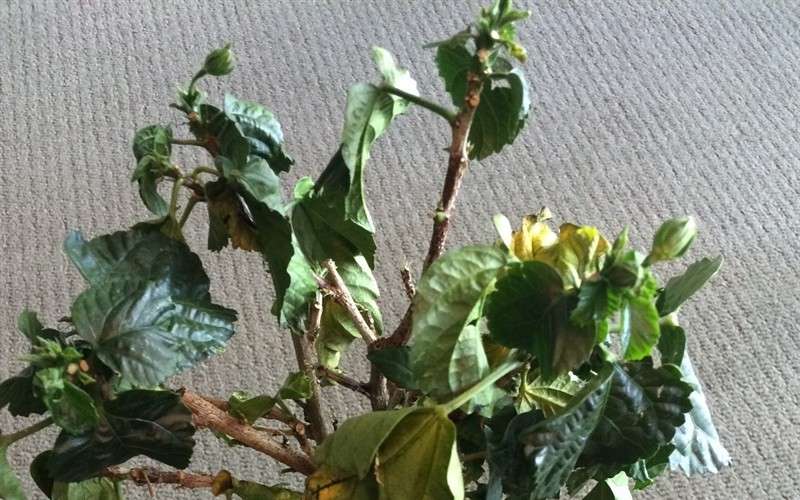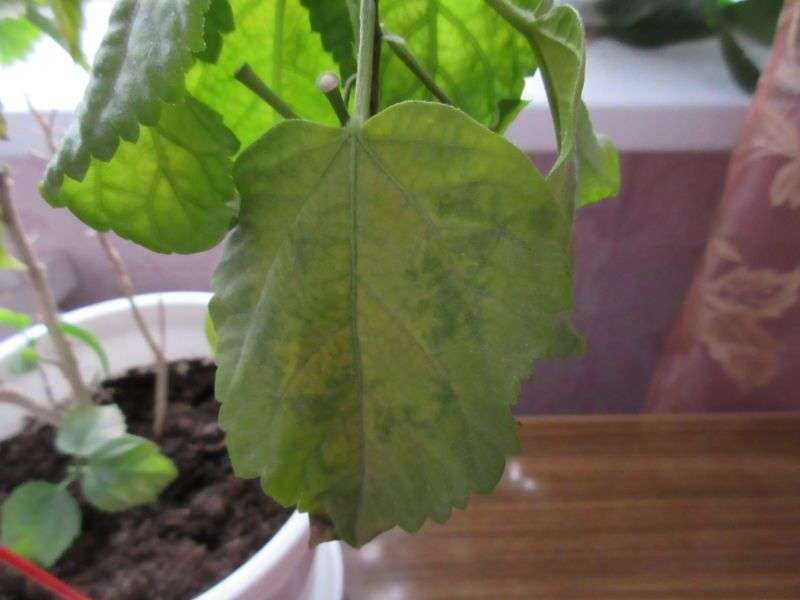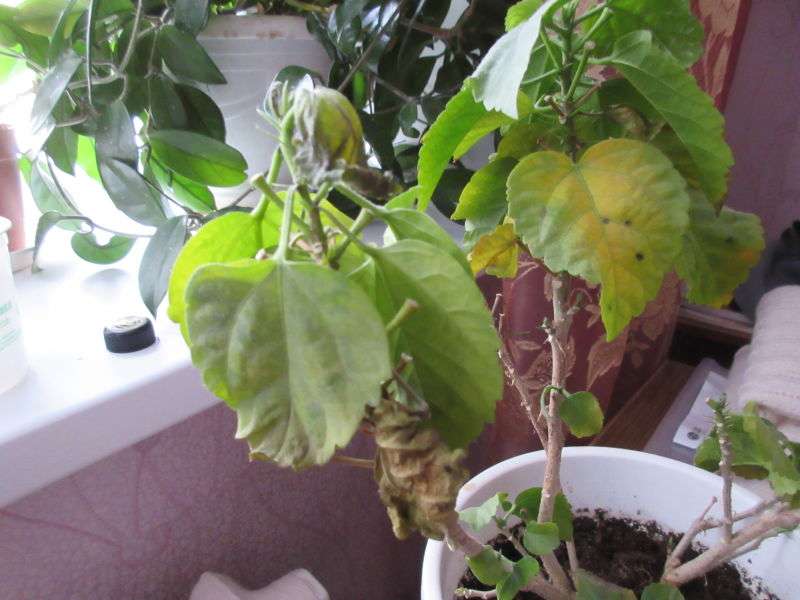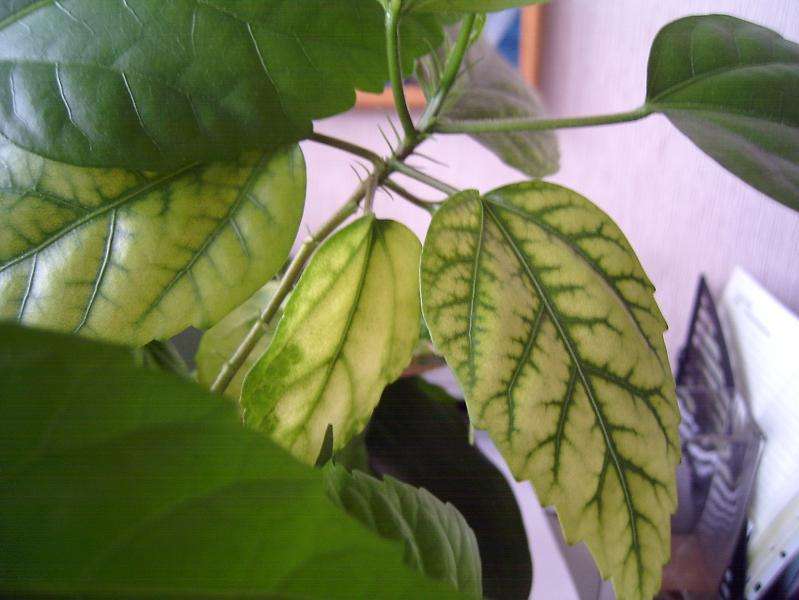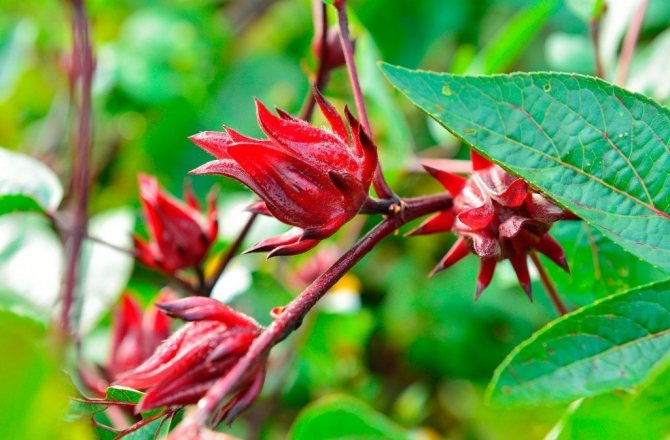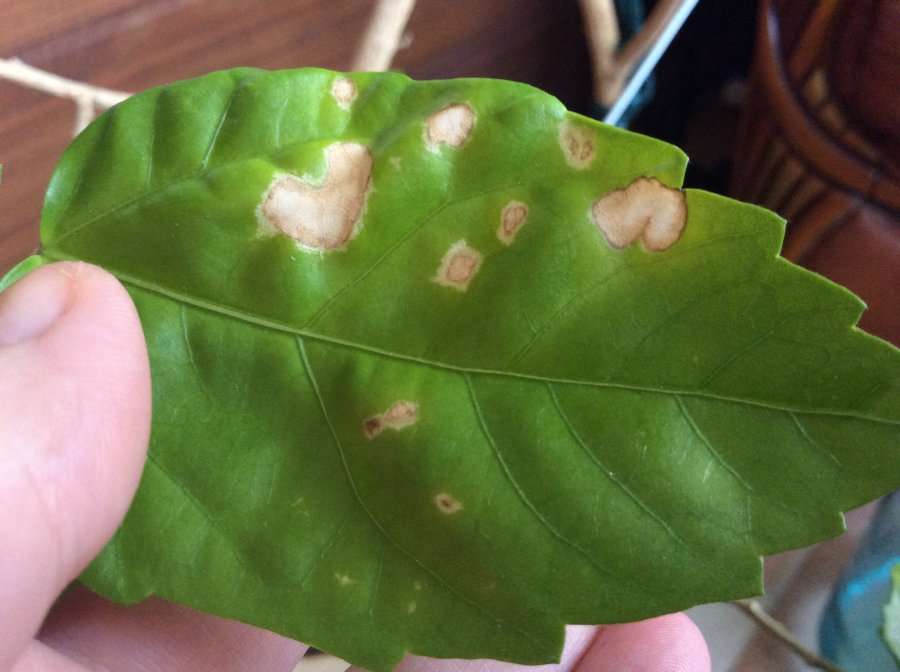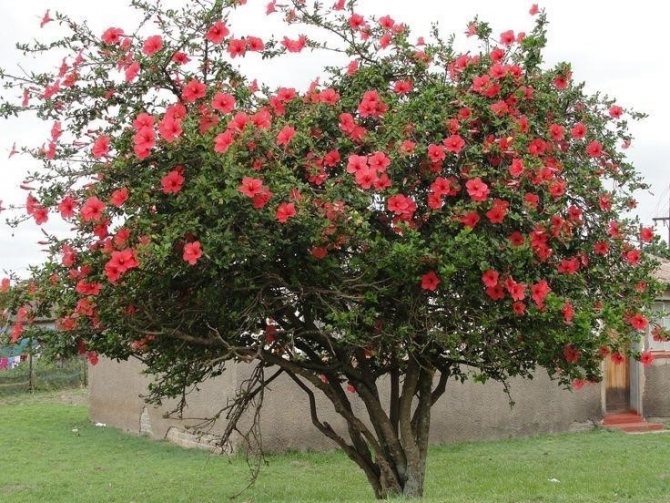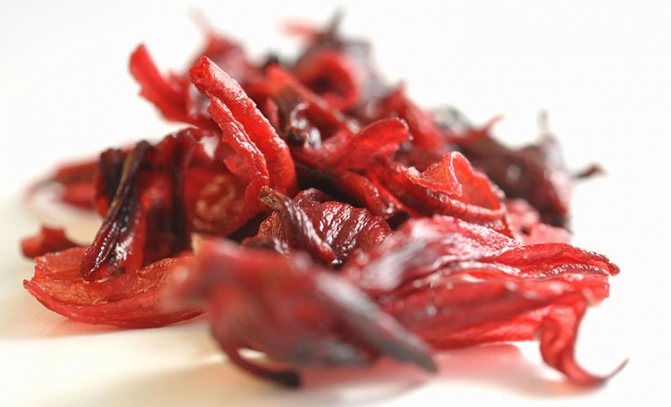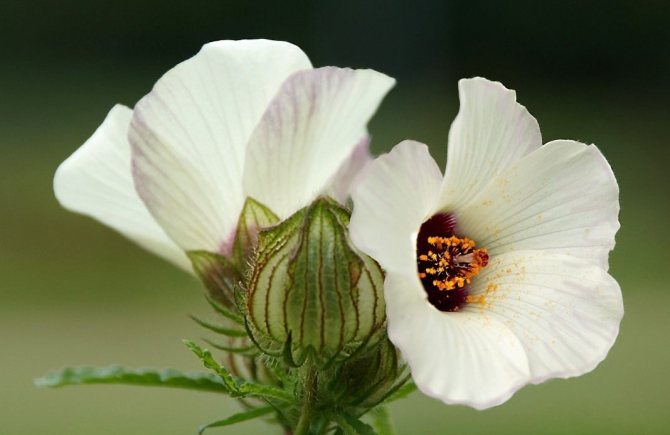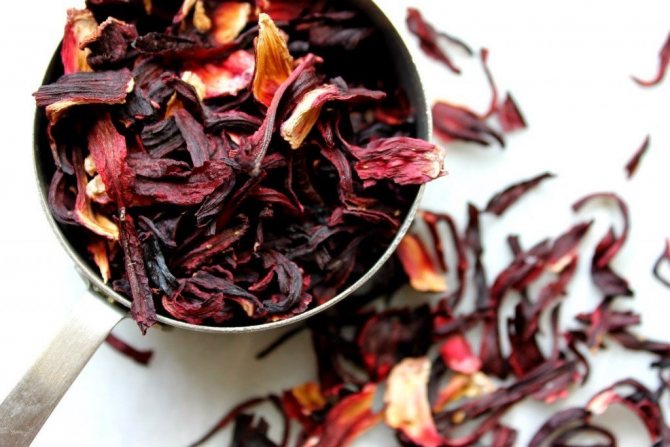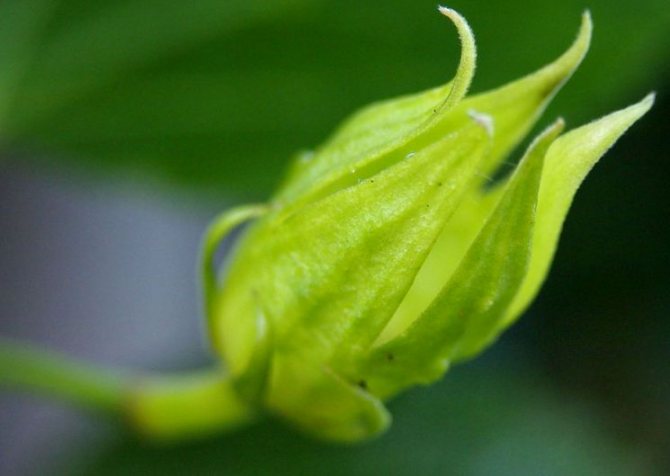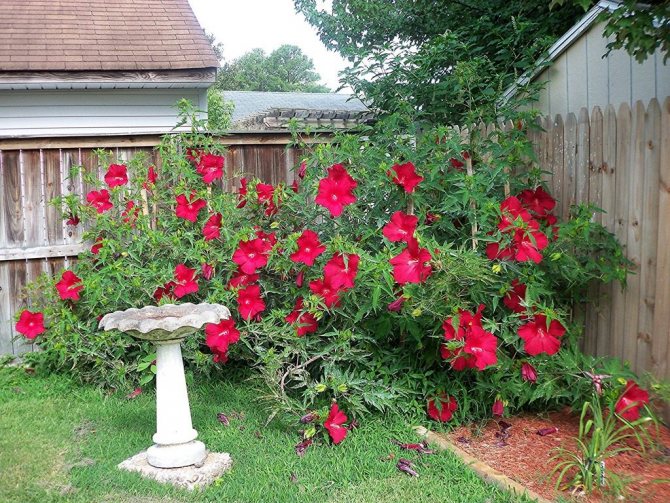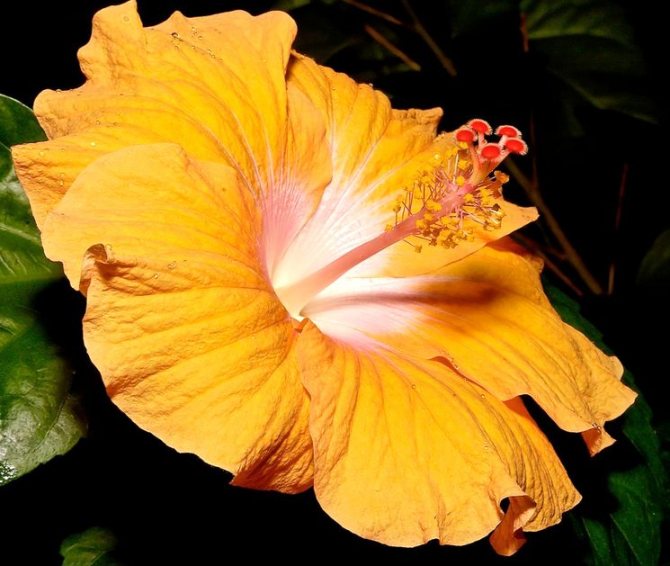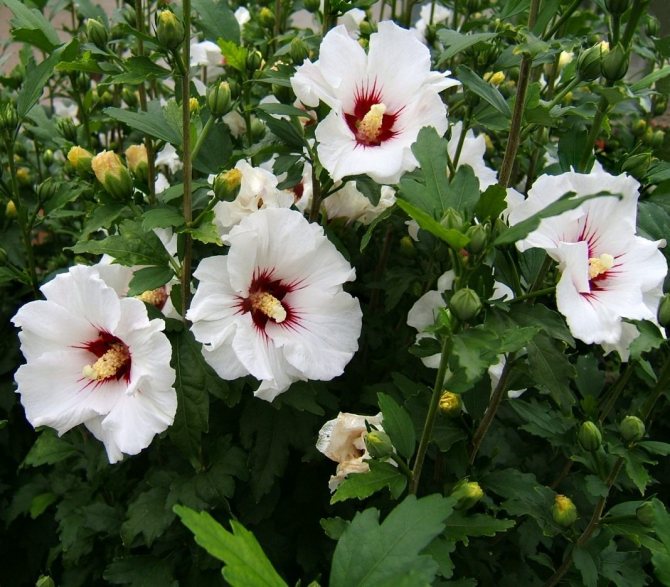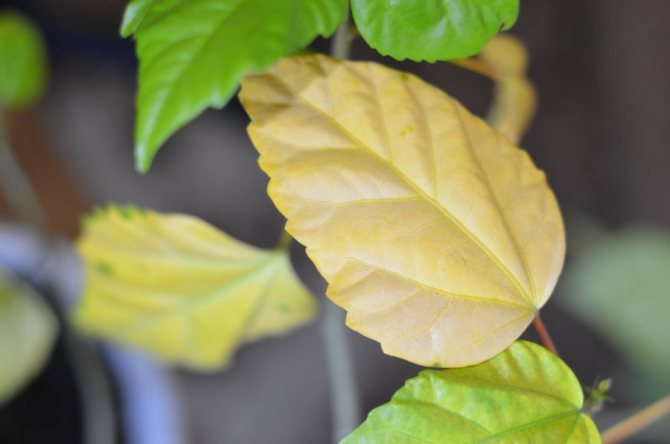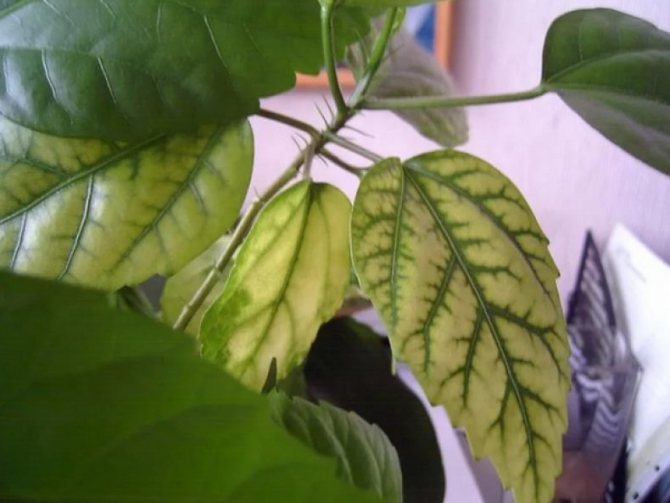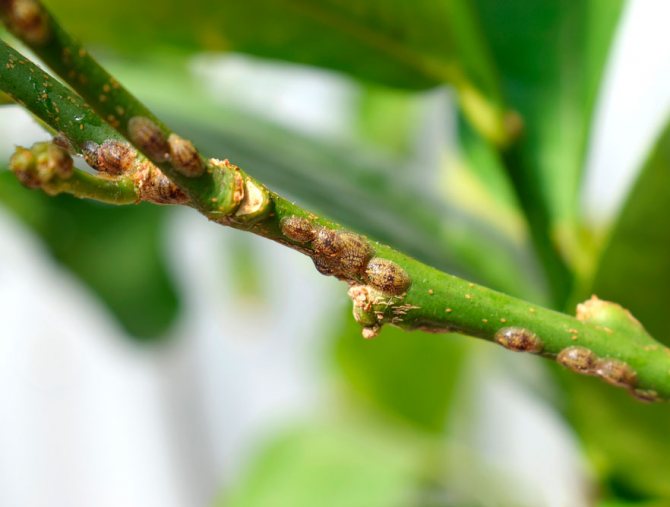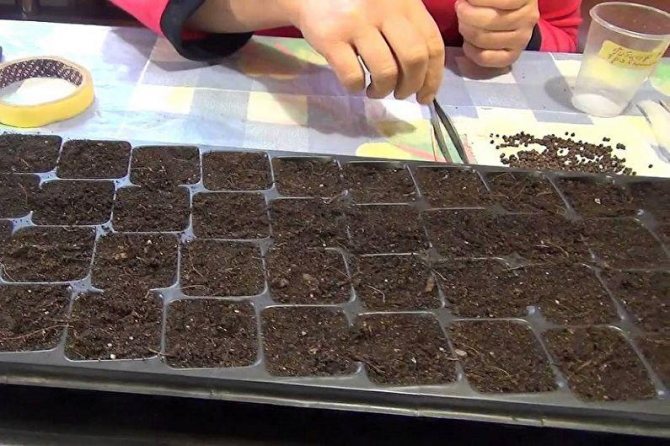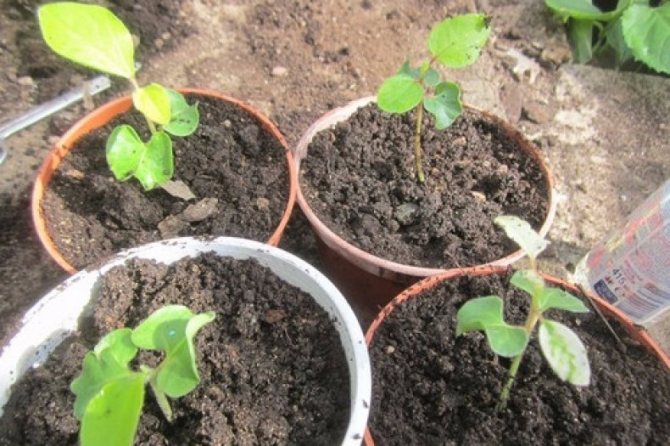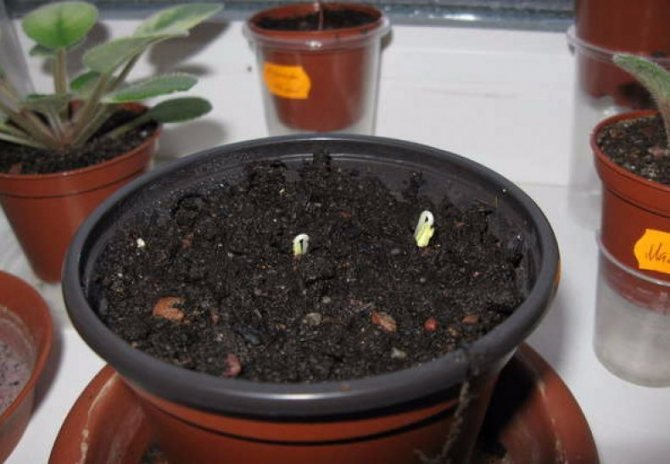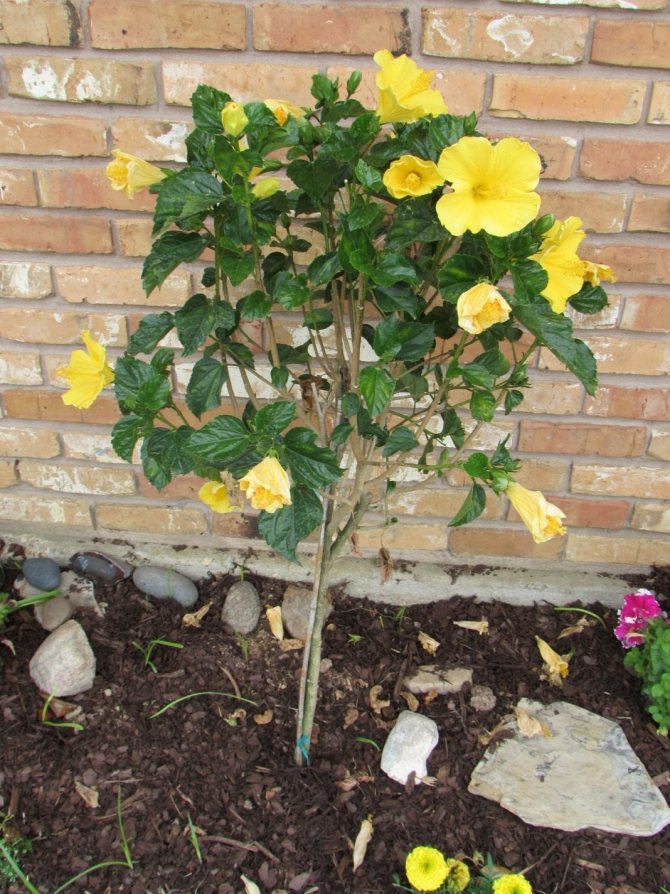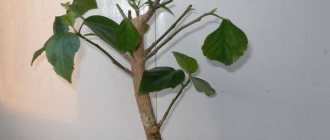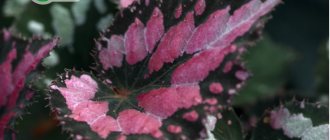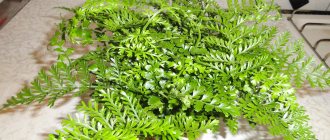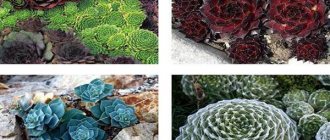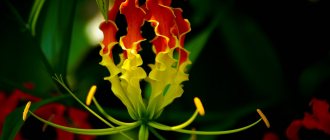Hibiscus is a herbaceous perennial plant that is common in subtropical climates. Hibiscus has beautiful flowers and easy maintenance, which is why it is often grown at home.
There are more than 100 plant species that differ in size and color. Hibiscus is also known as the Chinese rose, and the tea made from its petals is called hibiscus.
Due to its composition, hibiscus can be not only an ornamental plant, but also a medicine for the treatment of various diseases. It contains calcium, iron, magnesium, phosphorus, potassium, sodium and zinc. It also contains vitamin C and B vitamins.
The beneficial properties of hibiscus tea are complemented by anthocyanins.
Description
Hibiscus is a tropical heat-loving plant, so most of its varieties (there are about 300 of them) grows in Mexico, Sri Lanka, Malaysia, Egypt, Thailand, Sudan. By the way, the second name of the plant is "Sudanese rose".
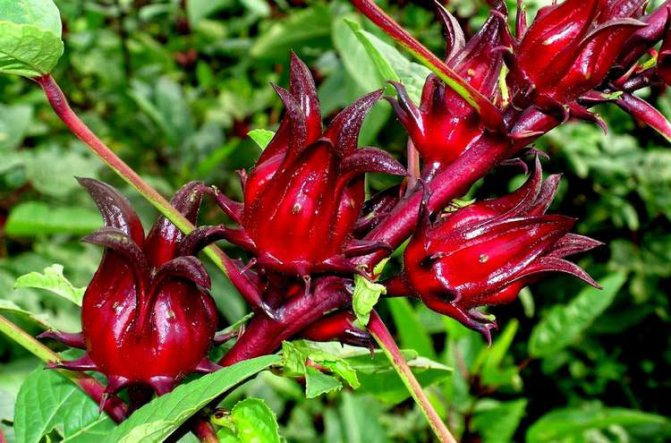
In Russia, hibiscus is not planted outdoors, but is grown on windowsills.
The plant is easily recognizable as its flowers have a deep red color. For medicinal purposes, it is customary to take six-day inflorescences and rhizomes (as shown in the photo), since during this period they absorb the greatest amount of nutrients.
Hibiscus tea is the national drink of the Egyptians. In Russia, it is also very popular and is used both for medicinal purposes and in nutrition and even in cosmetology. Tea made from Sudanese rose petals has different names: "Drink of the Pharaohs", "Red sorrel", "Rose of Sharon". But the name of the hibiscus stuck among the people.
Popular species and varieties
Hybrid hibiscus are bred by crossing such plant species as bright red, holly and marsh (read about planting, reproduction and caring for marsh hibiscus here). The flowers of the herbaceous perennial plant are very large and bright..
Copper King
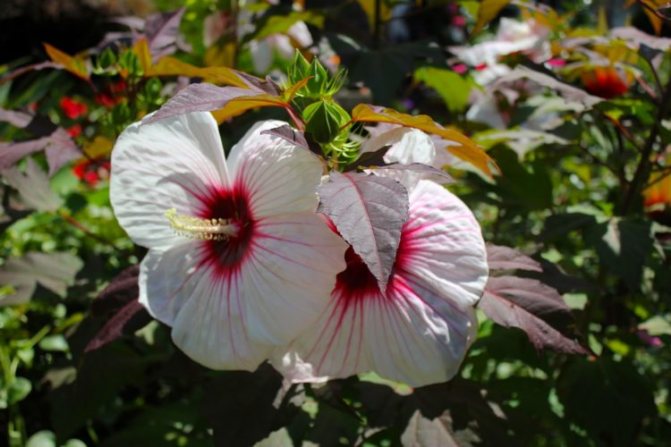

Hibiscus hybrid Copper King (Hibiscus moscheutos Kopper King) originally from Lincoln, Nebraska (USA). The Fleming brothers took him out. Perennial hybrid plant. Withstands frosts down to -30 degrees. It hibernates like peonies, buds in the ground, dying off for the winter, which determines its frost resistance.
In spring, the plant grows very quickly up to 120 cm, the bush is compact, strong and round. The foliage is copper-red. Flowers up to 30 cm in size, pink-white with a red eye and rays along the petals. Blooms from June to October. The plant thrives best in the sun or partial shade., in the shade, foliage will not be so spectacular.
Plum Crazy
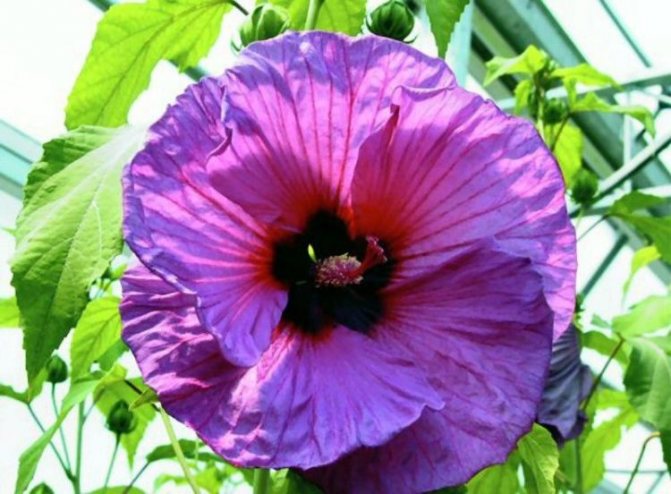

Plum Crazy (Hibiscus moscheutos Plum Crazy) is a perennial plant up to 150 cm high. Flowers with a diameter of 20 to 30 cm, blue with purple veins (therefore this variety is also called "Crazy Plum"), the center is darker, the edges are corrugated.
Plum Crazy can withstand frosts down to -30 degrees, as the aboveground part is cut off and dies off, from the powerful rhizomes that remain in the ground, new shoots appear in the spring, which grow very quickly. Plum Crazy is not picky about the soil, there is a relative resistance to drought and high - to diseases. Blooms from June to October.
Old Yella
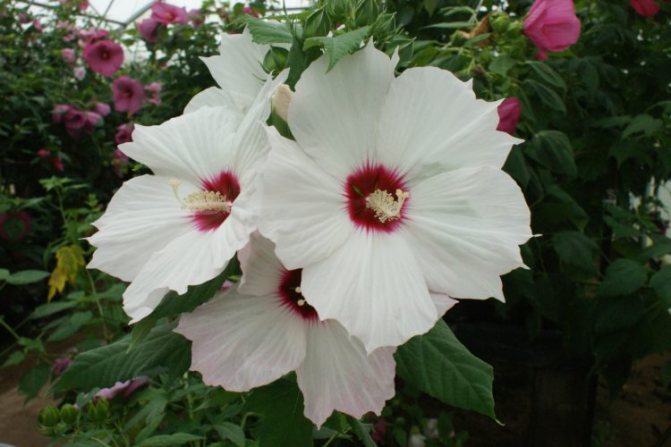

Hibiscus Old Yella (Hibiscus moscheutos Old Yella) up to 120 cm high, has a rounded crown with 3-5 finger-like leaves that resemble maple leaves.The color of the leaves is green, but after prolonged exposure to the sun, they acquire a purple hue. Old Yell's flowers are huge, wavy, 30 cm in diameter, creamy lemon-white with a small red eye. Old Yella blooms from July to late September.
Advice: To fully reveal the beauty of the plant, it must be planted in a sunny place.
The flower loves the soil nutritious, moderately moist, without stagnant water... Due to the withering away of the aboveground part, the shrub tolerates frosts well down to -30 degrees.
Robert Fleming


Hibiscus Robert Fleming (Hibiscus moscheutos Robert Fleming) in a temperate climatic zone grows up to a meter high, with a compact, strong and slightly rounded bush. Leaves similar to maple, 3-5 palmate, glossy, green in color. The flowers are bright red, with a dark eye and wavy petals overlapping each other, have a diameter of 30 cm.
The plant is resistant to diseases. Watering is necessary regular and abundant.
Cranberry Crash


The Cranberry Crush hybrid (Hibiscus moscheutos Cranberry Crush) is popularly called "Cranberry Pulp". The shrub grows lush, rounded, up to 120 cm high and 60-90 cm wide, with greenery from the very roots.
The foliage is feathery, green, with purple veins. Flowers up to 25 cm in diameter, color - juicy burgundy or crimson red, dark stripes on wavy petals. Cranberry Crash hardy (up to -30), winters in the ground... Blooms all summer until mid-September.
Fireball
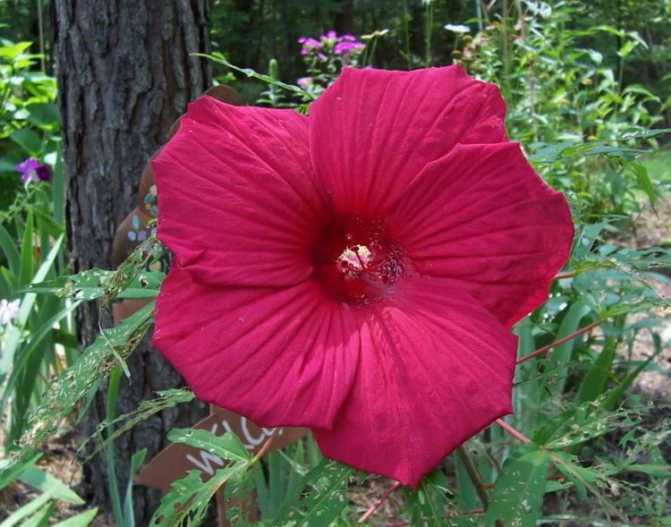

Fireball (Hibiscus moscheutos Fireball) up to 120 cm high, round and compact crown. Maple-like leaves are green with purple edges and veins. The flowers are fiery red, up to 30 cm in diameter with wavy, overlapping petals.
Fireball loves organic fertilized soil, when watering, water stagnation should be avoided. The plant hibernates in the soil, like peonies, at temperatures down to -30 degrees. Blooms from July to September.
Satellite


The satellite (Hibiscus moscheutos Satellite) is lower than other hybrid species, its height is only 75 cm. The foliage of a young plant is dark green, with purple veins, under the sun's rays the entire leaf becomes green-violet. A flower with a diameter of 25 cm, lilac-crimson color, the petals are on top of each other. The frost-resistant shrub, like all herbaceous hibiscus like it, hibernates in the ground at temperatures down to -30 degrees.
Kui Nuku


Kui Nuku hybrid (Hibiscus moscheutos Kui Nuku) 90 cm high... The foliage is dark green, becoming dark purple over time. The flower is large, its diameter is 25 cm. The petals are lilac-pink, there are 5 of them in one flower, which are found one on top of the other. The middle of the flower is darker. It hibernates in the ground at temperatures up to -30 degrees, in mulched soil.
Small Wonders
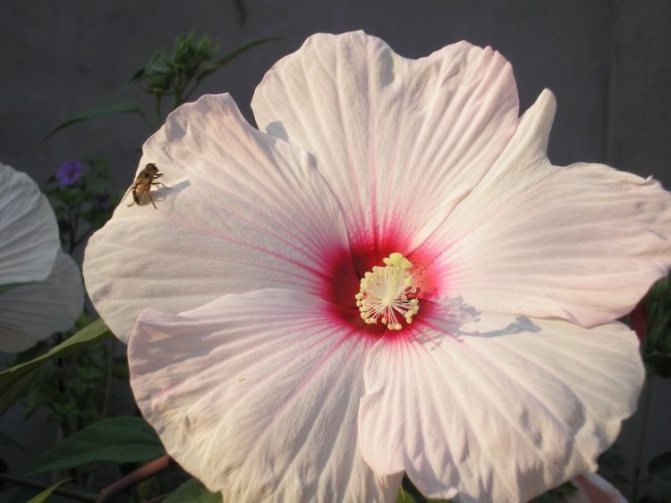

Small Wonders (Hibiscus moscheutos Small Wonders) of medium height. The bush is compact, an adult plant grows from 75 to 90 cm.The foliage of Small Wonders is dark green, towards the edges turns into burgundy. The variety of hibiscus hybrid Small Wonders frost-resistant.
Little Prince
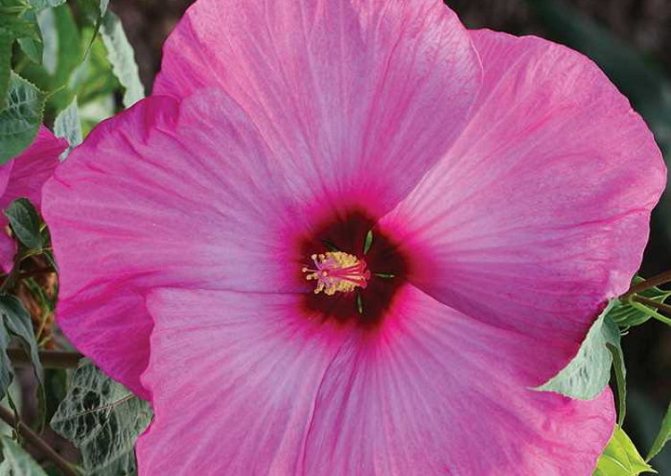

Little Prince (Hibiscus moscheutos Little Prince) - undersized, its height does not exceed 60 cm... The foliage of the plant is green, and the diameter of the flower reaches 25 cm.The color of the petals ranges from white to pink-red. Little Prince's bloom is abundant and long, the undersized bush is covered with huge flowers, which give the plant an exotic look.
Flowering begins in spring and continues until late autumn. After the end of flowering and with the appearance of the first frosts, the aerial part is cut off, and the plant hibernates in the mulched soil.
The composition of the drink
The beneficial properties of hibiscus are due to the unique chemical composition of the flowers of the plant. At the same time, despite the huge benefits for the body and the content of protein and carbohydrates in it, the calorie content is only 5 kcal per 100 g of the product.
Hibiscus flower contains:
The benefits of chubushnik tea
- beta carotene;
- micro and macro elements, including essential magnesium, phosphorus, calcium, etc .;
- antioxidant pectin;
- vitamins of group B, A, C and PP;
- vegetable flavonoids;
- organic acids;
- amino acids;
- anthocyanins;
- polysaccharides.
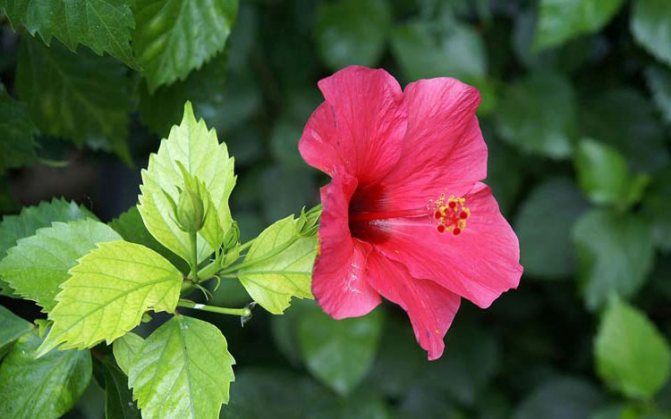

However, in addition to the petals, healers also use the leaves and fruits of the plant.
Sudanese rose leaves are rich in protein, cellulose, potassium, phosphorus. Nutritional value is 70% carbohydrates and 3.5% protein compounds.
Hibiscus fruits are undesirable for regular consumption, as they are very high in calories. 100 g of this product contains as much as 335 calories. But in small quantities, fruits can reward the body with iron, calcium, niacin and ascorbic acid.
Leaf diseases
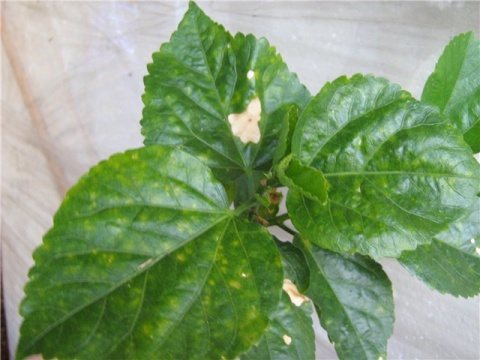

Separately, I would like to dwell on the problems and symptoms that arise with violations of the vital activity and development of the flower. Leaf diseases in most cases are triggered by chlorosis - a decrease in chlorophyll production in the green part of the plant. Below are the main symptoms of hibiscus distress, as well as their possible causes:
- Yellowing of leaves - pest infestation, plant root diseases, leaf chlorosis, poor indoor air humidification.
- Fall of hibiscus leaves - low humidity, no spraying, sudden changes in lighting, drafts, and other types of stress for the flower.
- Yellowing, coupled with falling leaves - waterlogging of the root system in winter, stress, low humidity in the room.
- Rolling the leaves into tubules is the defeat of aphids or some other pests.
- Withering of the tips of the leaves - a lack of nitrogen, phosphorus, and other nutrients, a complete lack of complementary foods for hibiscus.
- The general wilting of the leaves and the whole flower is an excess of the temperature in the room above the norm, a decrease in humidity to low levels.
- Dropping leaves and buds by a plant - lack of the required amount of potassium in the soil, damage to leaves by gall midges, high temperature in the room.
Application methods
The "royal" flower, as it is called in the East, has a wide range of applications. Hibiscus is actively used in cooking, including for the preparation of compotes, desserts, jams - it is a natural dye and sweetener. Plants make a fragrant seasoning from dried flowers that goes well with meat dishes and vegetables.
Pharmaceutical companies create medicines based on hibiscus, including those from plant pollen. And in folk medicine, fortifying and healing infusions and decoctions are made from it. Based on the flowers and oil of the Chinese rose, they create cosmetic products for the care of the face, body and hair.
But most often the plant is used in the form of tea, which can be brewed both hot and cold. In terms of the content of vitamin C, this healing drink surpasses even rose hips, so it is especially worth increasing the frequency of its use during the period of colds.
Signs associated with hibiscus
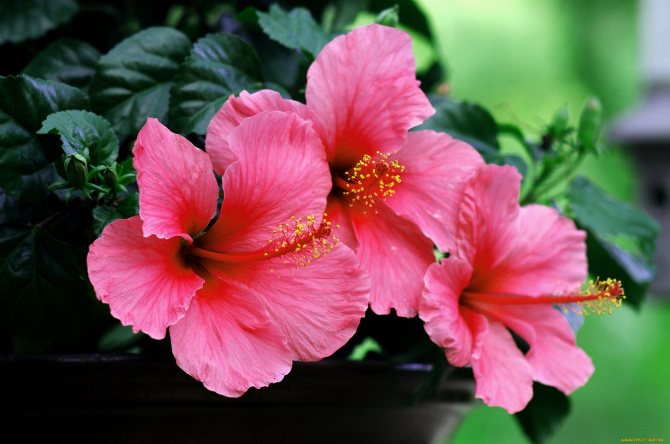

0
A source:
There are other signs associated with the Chinese rose, both positive and negative, among the people. The most common ones are:
- growing this shrub at home can provoke a man to leave the family. For this "superpower" hibiscus even received a creative name - muzhegon;
- during flowering, albeit short-term, quarrels, scandals, clashes over trifles begin in the house;
- in its natural environment, the plant blooms from late spring to about October. If the buds bloom unexpectedly - in early spring or winter, this is a signal of the death of one of the family members;
- dry leaves and blackened buds are also an unkind sign, signaling changes of a negative nature.
Indications for use
Hibiscus tea is recommended for colds or infectious diseases. The ascorbic and oxalic acids contained in the composition destroy pathogenic bacteria, and also increase the protective functions of the body. In addition, this drink works as an antipyretic agent.
Hibiscus is incredibly useful for people suffering from cardiovascular diseases, as well as from pressure drops. Thanks to the anthocyanins included in the composition, it strengthens the walls of blood vessels, and also purifies the blood. Hibiscus tea lowers cholesterol and blood sugar levels, which is an excellent prevention of diabetes.
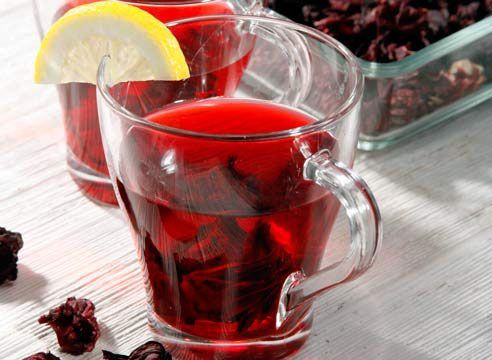

Depending on the temperature of consumption, hibiscus can have a twofold effect on blood pressure. So, a cold drink is designed to lower its performance, and a hot drink, on the contrary, to increase
Sudanese rose tea has the unique ability to remove toxins, free radicals and heavy metals from the body. Therefore, it is recommended to use it as a prophylactic agent against cancer, especially to people who live near industrial enterprises. This property also effectively manifests itself in the fight against alcohol intoxication, so hibiscus can easily replace cucumber pickle and hangover pills.
The presence of anti-inflammatory and antispasmodic components in the composition allows the use of hibiscus tea infusions as an expectorant and bactericidal agent for bronchitis, tracheitis, cystitis.


In addition, in medicine, external applications with hibiscus tea are used to cleanse and heal cuts, abscesses and purulent boils.
The hibiscus flower drink is a versatile remedy for gastrointestinal problems. It is able to suppress the growth of harmful bacteria without disturbing the correct intestinal microflora, as well as speed up the digestion process. Tea has an active choleretic effect, so it can serve as a prophylactic against bile stagnation.
Hibiscus is used for chronic constipation as a mild laxative. For this, it is recommended to apply the tea in a course of 10 days, making a strong infusion. Applying the infusion on an empty stomach, you can also get rid of parasites.
What to process
The question of how to treat hibiscus for diseases is very relevant in the presence of pests. If the prevention of diseases caused by pests turned out to be ineffective, then the following treatment methods are carried out:
- From aphids - treatment of the flower with Anabazine, Nicotine sulfate. It is recommended to change the drug more often - to Decis, Fitoverm, Intra-vir, Tobacco dust. With a single lesion of the leaves of aphids, treatment with a soap solution helps well.
- From scabbards - spraying with Actellik solution or other insecticides.
- From the worm - processing the leaves with mineral oil, which is done only when the plant is in the shade.
- From whitefly - treatment with Aktara, Karbofos, Iskra, Tanrek, Biotlin, Bison, applying potassium soap.
- From spider mites - washing the plant with soapy water, treatment with preparations Lightning, Vertimek, Akarin, Fitoverm.
- From gall midge - collection of affected buds, preventing them from falling to the soil. The soil itself must be treated with any medicine for soil pests.
The benefits of hibiscus for women
The fairer sex will be interested to know that linoleic acid, which is part of hibiscus, promotes active fat burning, which means that hibiscus tea should definitely be included in the diet when losing weight.
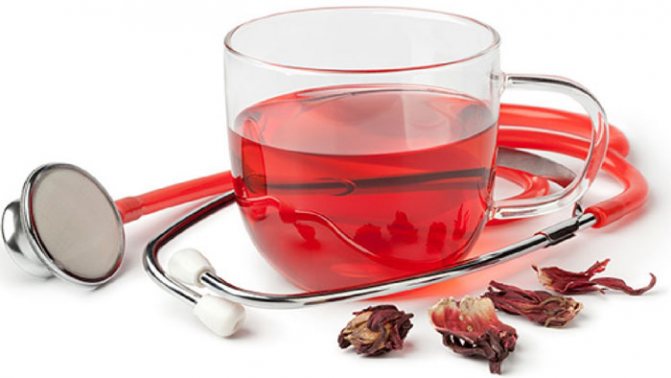

During pregnancy, this drink perfectly copes with toxicosis and reduces fatigue due to its rich vitamin composition.
In addition, the third trimester is often accompanied by uterine tone, and hibiscus is a natural antispasmodic and helps to quickly relieve muscle spasms.
Contraindications
There are no specific contraindications to the use of hibiscus. However, it is not recommended for people with gastric ulcer, duodenal ulcer, gastritis and high acidity, as well as for children under one year old.
With extreme caution, hibiscus drink can be consumed by persons prone to allergic reactions. It is forbidden to take in case of individual intolerance. During pregnancy, drinking a hibiscus drink is not recommended due to its ability to increase the tone of the uterus, which can provoke premature birth and miscarriages.
How to make a healthy drink
Hibiscus tea is prepared from dried hibiscus petals at the rate of one tablespoon per 400 ml of water. It is not recommended to use metal utensils for brewing, as they can spoil the taste and color of the drink.
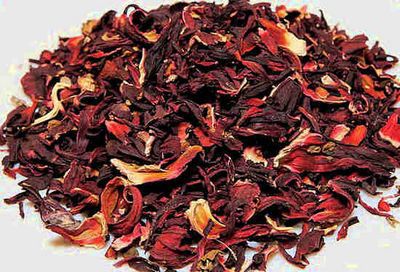

Hibiscus tea is healthier when prepared cold
To do this, the flowers must be poured over with cold water and left to infuse overnight. The plant perfectly gives its useful properties and at the same time retains the irreplaceable vitamin C and a pleasant sweet and sour taste.
Hibiscus tea is a storehouse of vitamins, minerals and other useful substances. It can be drunk at any time of the year to quench thirst and prevent the development of many diseases. Make this invigorating drink an integral part of family tea, especially on cold winter evenings.
Symptoms of diseases
Hibiscus leaves turn yellow. The most likely causes of the disease are pests (aphids, spider mites), diseases of the root system, insufficient air humidity or chlorosis of the leaves. Chlorosis is caused by an excess of chlorine and calcium in irrigation water with a lack of nitrogen and iron. Water for watering the plant should be defended and iron chelate added.
Hibiscus leaves fall. Stress, lack of moisture. It is necessary to create rest for the plant and spray.
Indoor hibiscus - leaves turn yellow and fall. Stress, insufficient humidity, draft, waterlogged roots in winter. It is necessary to create rest for the plant, spray, making sure that the bud does not turn into a liquid mess.
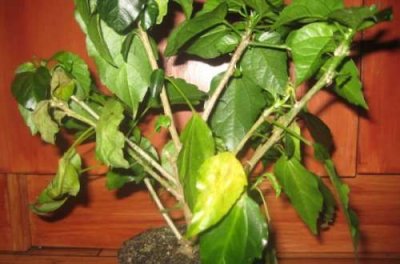

Why do hibiscus leaves curl? ... The plant is affected by aphids. It is necessary to treat pests.
Hibiscus leaves wither. Lack of nutrients. It is necessary to feed the plant with nitrogen and phosphorus preparations.
The hibiscus withers. The plant is too hot. It is necessary to reduce the room temperature, shade, spray.
Why does hibiscus shed its buds? The plant is too hot. The soil lacks potash fertilizers. The buds are affected by the gall midge.

